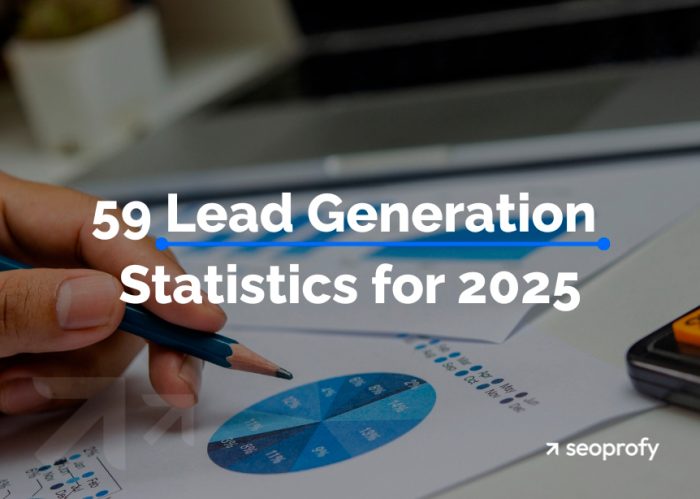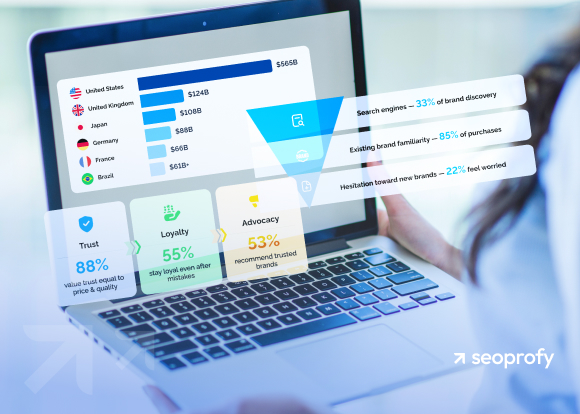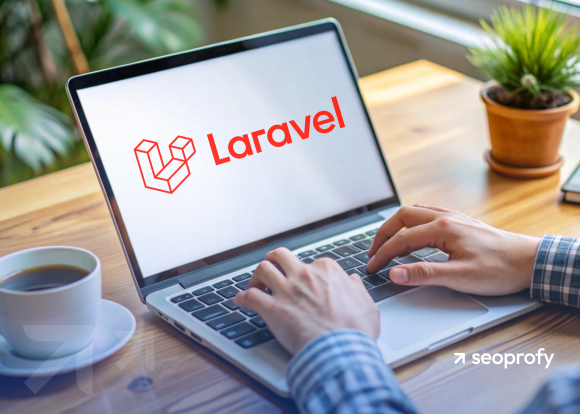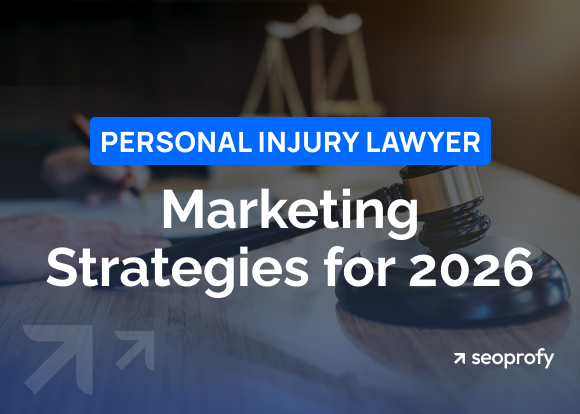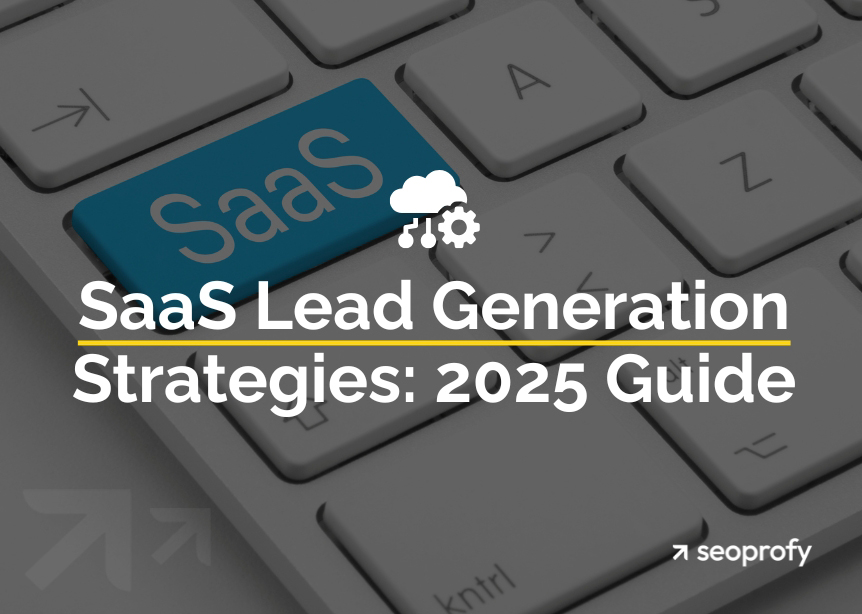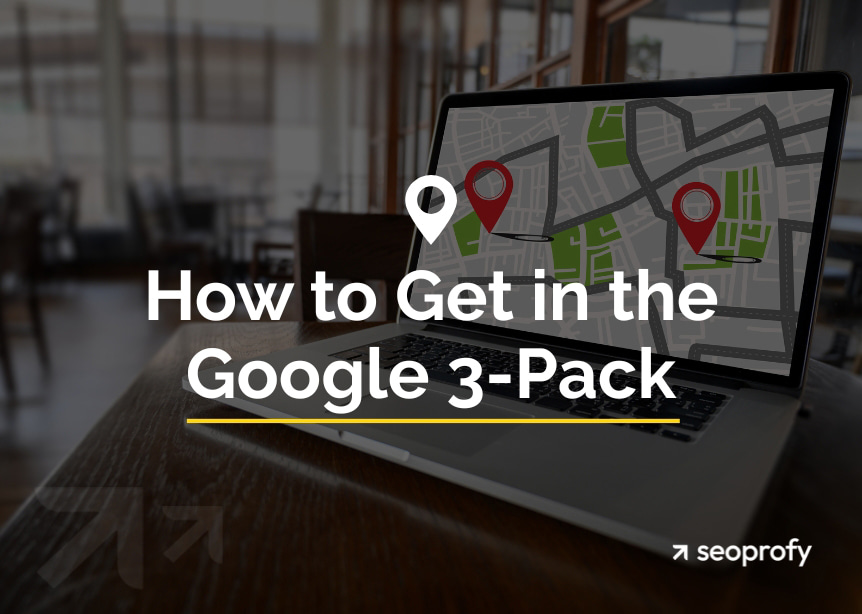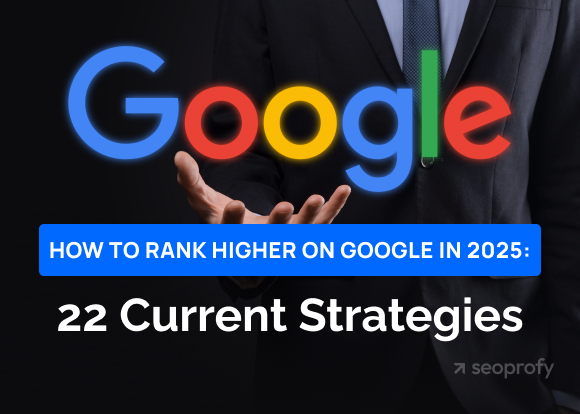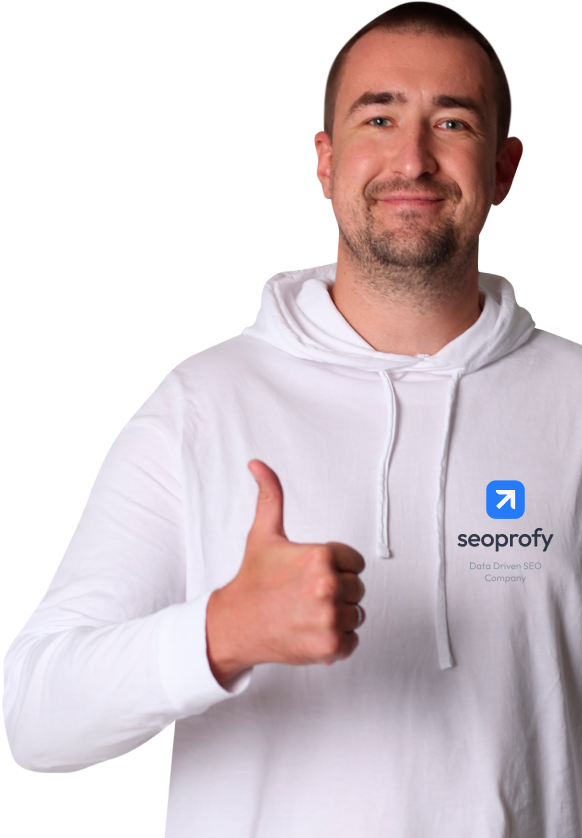How much does a lead cost in 2025? While the final figure varies by niche and acquisition channel, the average ranges from $10 to over $900 per client. This report compiles current lead generation data from HubSpot, First Page Sage, and other credible sources to help businesses improve their lead generation strategies while reducing acquisition costs.
Although many modern businesses strive to adapt to the latest trends, such as AI-driven search results, their primary goal remains unchanged. They need not only to catch the attention of the target audience but also to convert as many people as possible into their paying clients.
Using real data from trustworthy sources, we’ll analyze average conversion rates and general trends. Moreover, you can use some of the insights from our lead generation statistics to improve your business processes.
- The average cost per lead is $198.44.
- A mid-sized company typically generates fewer than 500 qualified leads per month.
- The average conversion rate is 2.9%.
- Nurturing your clients increases their chances of making a purchase by 47%.
Cost Per Lead Benchmarks
First, let’s review general lead generation statistics to estimate how many clients a brand can acquire and what the associated costs will be. Our SEO company has prepared data that covers all the basics and helps you understand the differences between conversions across various industries.
Average CPL by Industry
Of course, when it comes to converting your audience into clients, your niche significantly matters. At the same time, our lead generation statistics reveal noteworthy insights, which may help you acquire more customers regardless of your industry. Let’s dive deeper into this essential data to break down lead costs across various niches and gain some useful tips.
- The average cost per lead across all industries is $198.44. (Revnew)
- The higher education industry has the highest average cost per lead rate, which is $982. (First Page Sage)
Here are the other top 5 industries with the highest CPLs
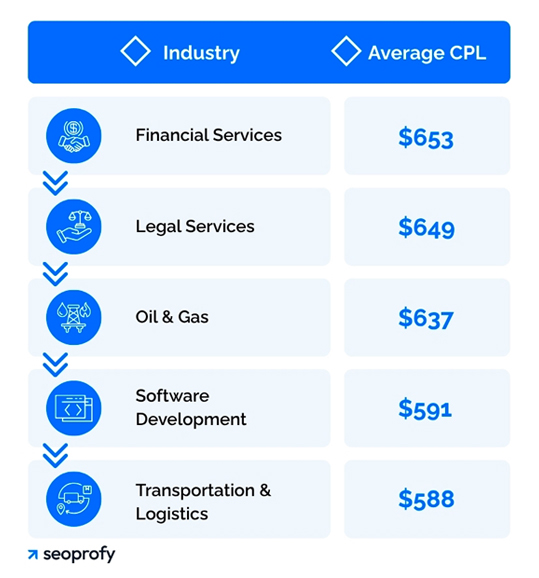
| Industry | Average CPL |
| Financial Services | $653 |
| Legal Services | $649 |
| Oil & Gas | $637 |
| Software Development | $591 |
| Transportation & Logistics | $588 |
- The lowest average CPL is in the eCommerce industry, where it’s only $91. (First Page Sage)
- Nearly 78% of small businesses typically spend from $100 to $1,000 per month to generate leads. (WebFX)
As a rule, smaller businesses have websites with a simpler structure and fewer pages. Thus, unlike large companies, they don’t need to spend as much time and resources optimizing their sites for lead generation.
- 50% of medium-sized companies spend from $1,001 to $5,000 monthly on lead generation. (WebFX)
- The development and implementation of lead generation strategies cost enterprise companies from $5,001 to $100,000. (WebFX)
- Businesses that leverage data-driven lead generation strategies achieve a 5-8x higher ROI. (Perform)
- 53% of marketers spend 50% or more of their budget on generating leads. (Perform)
- The lead generation industry is expected to reach a value of $3.7 billion by 2027. (Perform)
- Lead generation is the most important goal for 91% of marketers. (Ruler)
- Over 96% of businesses are satisfied with the ROI they receive from their lead generation strategies. (WebFX)
B2B vs. B2C Lead Costs
Whether you run a B2B or B2C business, generating more prospective clients is definitely your primary goal. At the same time, business-to-business companies often have to spend more money to convert people into clients due to longer sales cycles. Additionally, there are other lead generation trends inherent in both B2B and B2C markets. So, let’s examine how much it costs for a company to acquire a lead depending on its business model.
- B2B businesses operating in the SaaS industry typically spend $310 per lead obtained through paid campaigns. The CPL for blended marketing is $237, while for the organic one, it’s only $164. (First Page Sage)
- 69% of B2B companies plan to increase their investments in lead generation. (EBM)
- 91% of B2B marketers report lead generation as their top priority, understanding it requires sustained engagement. (SEMA Brands)
- Trade shows and in-person events have the highest average CPL among the B2B marketing channels, which is $811. (VisitorQueue)
Here is a table reviewing the average CPL of other channels used by B2B marketers:
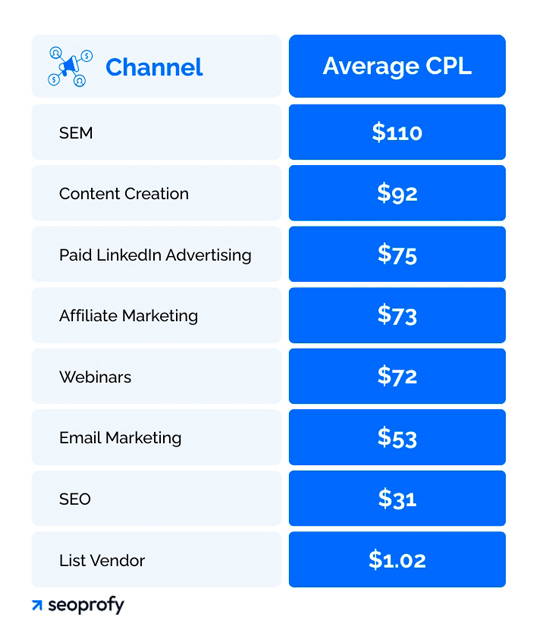
| Channel | Average CPL |
| SEM | $110 |
| Content Creation | $92 |
| Paid LinkedIn Advertising | $75 |
| Affiliate Marketing | $73 |
| Webinars | $72 |
| Email Marketing | $53 |
| SEO | $31 |
| List Vendor | $1.02 |
- B2B lead generation pricing ranges from $2,500 to $12,000+ per month. (B2B Marketing Coach)
- A typical small-to-midsized business spends between $9,000 and $10,000 per month on pay-per-click (PPC) advertising. (WebFX)
- The B2C lead generation via SEO strategy costs from $1,500 to $5,000 per month. The price of a one-time project varies from $5,000 to $30,000. (WebFX)
- B2C businesses spend from $2,000 to $50,000 per month on content marketing for lead generation. The price directly depends on how much content a company wants to create for its website. (WebFX)
Lead Volume & Conversion Trends
Implementing trendy tools and methods to improve your lead generation process is undoubtedly a great idea. However, you should also understand the stages a person goes through before they become your loyal client. Check our lead generation statistics to discover the key particulars of each benchmark and learn more about conversion rates in popular industries.
Lead Volume Benchmarks
Our lead generation report also covers benchmarks, which allow you to estimate how well your company is doing in acquiring and converting potential clients. Meeting these specific and measurable targets means that your current strategy is effective enough to ensure the further growth of your business. However, if you notice that you don’t meet the average metrics in your industry, it’s a clear sign that you need to make improvements ASAP.
- The majority of mid-sized companies typically generate fewer than 500 qualified leads per month. (Revnew)
- Most mid-sized companies generate fewer than 500 qualified leads monthly, while larger B2B firms can exceed 1,800 per month. (Revnew)
- In June 2023, B2C companies had 196.5 new leads, which was over seven times more than B2B companies. (Databox)
- B2C companies have a landing page view-to-submission rate of nearly 10%, while B2B businesses have only slightly higher than 7%. (Databox)
- Both B2B and B2C companies maintain nearly 27-32 landing pages, which allows them to target different segments of their audience, tailor content for specific needs, and highlight different products or services. (Databox)
- While B2C businesses can boast an average of 135 new contracts, the median for B2B companies is 54.4. (Databox)
- When it comes to estimating leads’ potential value, 40% of them are scored between 41 and 60 (out of 100). (Databox)
Conversion Rates by Industry
A conversion rate indicates the percentage of leads that complete a purchase of your products or services. It’s essential to keep an eye on this metric to ensure that your website and current marketing campaign contribute to achieving your business goals. At the same time, consider that each industry has a different average conversion rate. Check our lead generation statistics and compare them with yours.
- The lowest conversion rate is in the software development industry, where it’s only 1.1%. (First Page Sage)
Here, you can also find other niches with low average conversion rates:
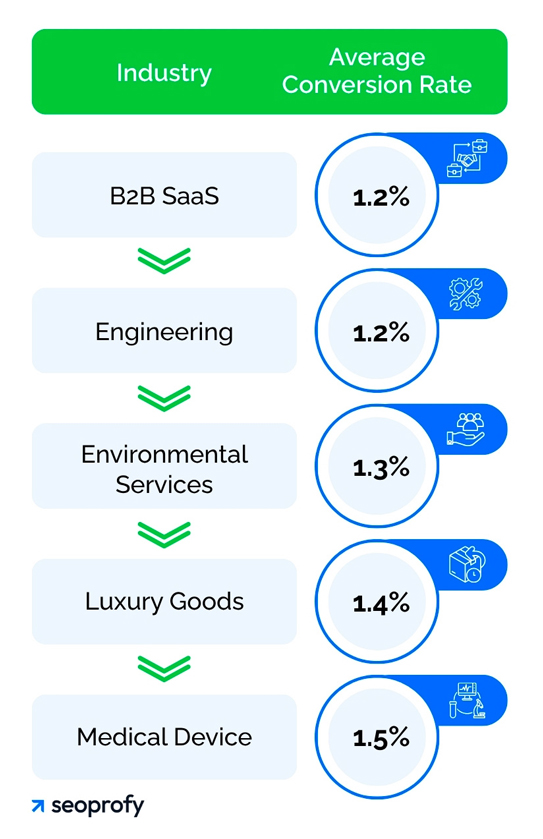
| Industry | Average Conversion Rate |
| B2B SaaS | 1.2% |
| Engineering | 1.2% |
| Environmental Services | 1.3% |
| Luxury Goods | 1.4% |
| Medical Device | 1.5% |
- eCommerce has a 2.2% average conversion rate. (First Page Sage)
- The average conversion rate across all the popular industries is 2.9%. (Ruler)
- A website conversion rate between 2% and 5% across all industries is considered to be “good.” (Intuit)
What Happens to Most Leads
After looking at the average conversion rates in various industries, you probably wonder what happens to all your other potential customers. We’ve analyzed lead generation trends to come up with the answer, revealing the harsh truth. At the same time, you’ll also learn how lead nurturing can help you inspire more people to make purchases and even reduce the acquisition costs of your clients.
- 96% of your website visitors aren’t ready to make a purchase. (Adobe for Business)
- 80% of your new leads will never buy your products or services. (Invesp)
- 50% of leads are qualified but still not ready to buy. (HubSpot)
- 44% of companies report poor lead quality as one of their sales teams’ problems. (Acend2)
- For 41% of businesses, following up with their leads is a challenging task. (Acend2)
- Companies that opt for lead nurturing generate 50% more sales-ready leads while reducing acquisition costs by 33%. (Invesp)
- Nurturing leads typically results in a 20% increase in sales. (Invesp)
- Excelling in lead nurturing allows companies to generate 50% more sales-ready leads while reducing the cost per lead by 33%. (Marketo)
- Nurtured leads are 47% more likely to make a purchase, and companies that implement lead nurturing strategies see 50% more sales-qualified leads at 33% lower acquisition costs. (Invesp)
- Over 35% of B2B marketers have already developed and implemented a lead-nurturing strategy. (Invesp)
Top Lead Generation Channels in 2025
There are numerous ways to boost your lead generation efforts, including implementing the right SEO strategy, crafting useful content, posting videos on social media, etc. However, which one of these channels is the most effective in 2025? Keep reading our report to find out the answer. Also, you are welcome to learn more about strategies that can boost your business and increase the number of leads with the help of SEO.
Content & SEO
Content is king, and when you combine it with an appropriate SEO strategy, you’ll surely increase your rankings, eventually leading to increased lead generation. Clear site architecture and useful blog posts attract your potential customers, build trust, and guide them through the sales funnel. The lead generation statistics prove the importance of content and search engine optimization for your revenue. Plus, don’t forget to learn about SEO ROI in more detail to uncover the full potential of this digital marketing technique.
- Lead generation is the third most important metric when it comes to measuring the efficiency of a content marketing strategy. (HubSpot)
- 82% of B2B marketers say that understanding their audience has significantly contributed to their success. Also, 77% of marketing specialists admit the importance of high lead quality. (CMI)
- Brands that publish 16–20 blog posts monthly generate over 3x more leads than those that post infrequently. (HubSpot)
- Companies that have over 200 total articles in their blogs acquire 3.5 times more leads than those with under 20 blog posts. (HubSpot)
- 58% of B2B marketers say that video is the most effective type of content. It’s followed by case studies (53%), e-books (45%), research reports (45%), and short blog posts (45%). (Content Marketing Institute)
- Two-thirds of the US B2B buyers look for clients online before making a purchase. (Statista)
- SEO leads have a 14.6% close rate, while outbound marketing efforts have only a 1.7%. (SeoProfy)
- 35% of respondents say that SEO is the top source of high-scoring leads. (Databox)
Social Media Marketing
According to the latest lead generation statistics, both B2C and B2B businesses utilize social media to connect with their customers, promote their brands, and establish their credibility. For instance, social media posts are among the main types of content to consider if you want to generate lawyer niche leads. Further, other industries can also benefit from utilizing this powerful marketing channel by implementing the trends from the statistics mentioned below.
- 36% of social media marketers say that social media is among the most effective sales channels. (HubSpot)
- The average cost per lead for Facebook Ads across all industries is $23.10. (Datawrapper)
- Companies with over 1,000 Facebook fans, on average, generate 12 times more leads than their competitors with a smaller Facebook audience. (HubSpot)
- 89% of B2B marketers opt for LinkedIn to generate leads. (LinkedIn)
- 62% of B2B marketing experts claim LinkedIn generates leads at twice the rate of the next best-performing social media channel. (LinkedIn)
- 50% of the B2B consumers who use social media for making buying decisions trust LinkedIn. (LinkedIn)
- Sales professionals claim that 33% of the highest quality leads come from existing customers’ referrals. A similar number is for social media. (HubSpot)
Email Marketing
Although some experts consider email marketing outdated, it’s actually an excellent and cost-effective way to directly reach potential customers and drive conversions. It allows you to impact your business growth by delivering targeted content, building trust, and providing personalized offers to your prospective clients. Additionally, our lead generation stats include insights that prove that the days of email marketing aren’t over yet.
- Lead-nurturing emails are 4–10 times more likely to inspire a person to respond. (Invesp)
- Emails that include the word “free” in their subject line are 10% more likely to be opened than those without it. (Invesp)
- The average reply rate for cold email outreach campaigns ranges from 8% to 10%. (Saleshandy)
- Letters with more than 3 words in their subject lines experience a reduction in open rate by over 60%. (Rikvin)
- An average consumer receives over 100 emails daily but opens only 23% of them and clicks on just 2%. (HiveHouse Digital)
Conclusion
Regardless of the business you run, generating new leads every month is essential for ensuring its successful growth. Although this is one of the most challenging tasks, all marketers agree that it should be an integral part of their overall strategy.
Our lead generation statistics prove that a proper combination of content, SEO, SMM, and email marketing can create an ecosystem that will regularly attract potential clients. Moreover, you must tailor your efforts to your industry’s specific characteristics and trends. In this case, you’ll not only generate leads but also convert them into sales.


